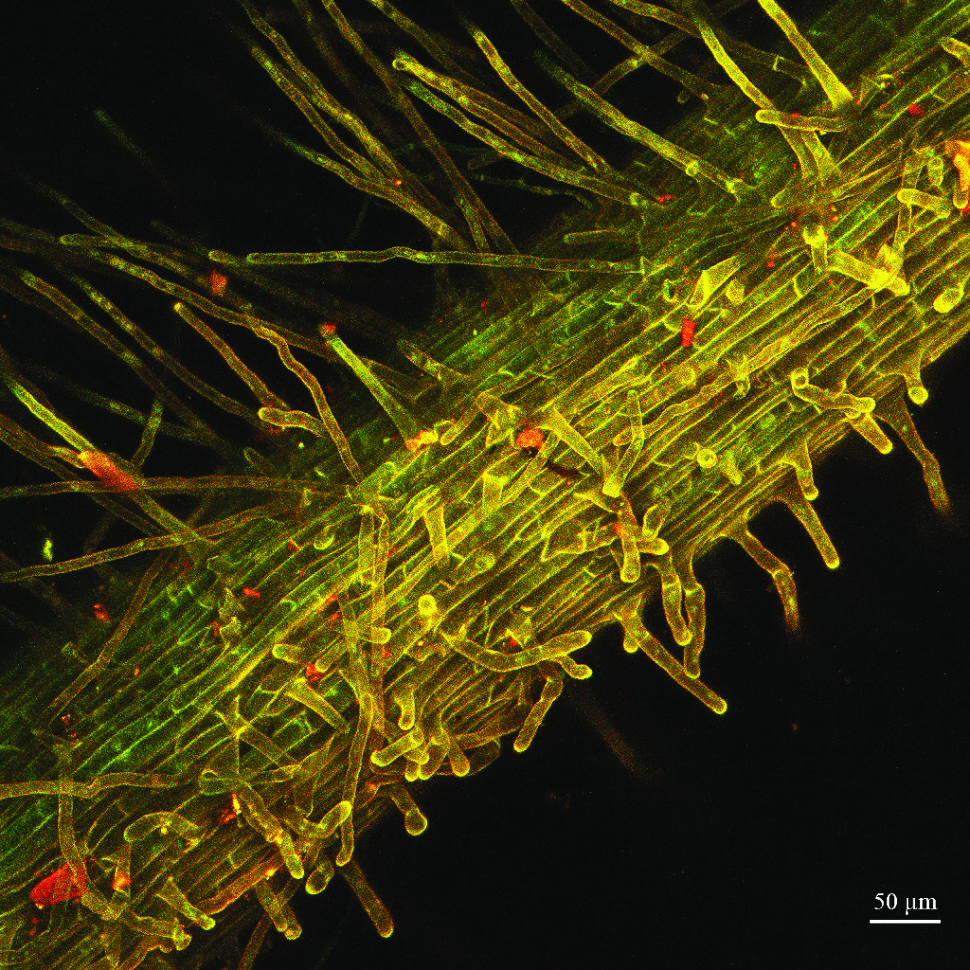Understand the genomic properties of plants, microbes, and their interactions to enable the development of new approaches that improve the efficacy of bioenergy crop production on marginal lands with few or no agricultural inputs, while minimizing ecological impacts under changing environmental conditions.

Characterizing Plant-Microbe Interfaces. This confocal image shows the microbial isolate Variovorax CF313 (green) colonizing transgenic Populus PdKOR roots. Better understanding of the symbiotic relationships between organisms can help researchers engineer hardier bioenergy crops and more productive ecosystems. [Courtesy Oak Ridge National Laboratory]
The GSP supports research on diverse sustainability-related topics, including soil health, microbial processes and their interactions with bioenergy crops, improvements in the value chain for biomass conversion, and the biology of bioenergy plants. Opportunities to manipulate and engineer biological mechanisms for improved biomass production in plants may generate compounding returns when intersected with deeper knowledge of factors that control nutrient and water use efficiency by plants, fungi, and soil microorganisms.
In this context, GSP closely cooperates with other DOE programs, such as the Advanced Research Projects Agency-Energy (ARPA-E) and Office of Energy Efficiency and Renewable Energy, as well as other federal agencies. To better understand spatial and temporal environmental impacts of energy crop growth and production, GSP will also coordinate with BER’s Earth and Environmental Systems Sciences Division (EESSD) on ecological modeling and leverage EESSD user facilities such as EMSL.
Important GSP objectives for sustainable bioenergy research are to:
- Develop high-throughput, nondestructive, and analytical techniques to measure plant and microbial phenotypes or functional processes in the environment.
- Expand understanding of genetic diversity and validate the functions of genes, genomic regulatory networks, and metabolites in plants and microbes, particularly those that enable crop adaptation to extreme conditions, changing environments, and episodic environmental events.
- Use biological data to model resource allocations and bottlenecks within bioenergy crop production systems to identify plant functional properties that can be modified to increase biomass degradability, increase yield, and enhance other desirable traits.
- Advance understanding of plant-microbe interactions and their influence on plant growth and stress responses and improve insights on how microbiome and plant diversity help deliver sustained ecological services in the environment.
- Understand microbially mediated soil biogeochemical processes (e.g., nitrogen cycling, greenhouse gas emissions, or carbon stabilization) and their impact on the sustainability of bioenergy cropping systems.
- Develop computational tools to process and use complex and large data architectures that include physiological, molecular, and spatial information such as above- and belowground plant architecture, soil chemistry, nutrient and water use efficiency, and multiomics data.
- Develop process-based, multiscale models to predict cropping and ecosystem behavior under changing environmental conditions.
